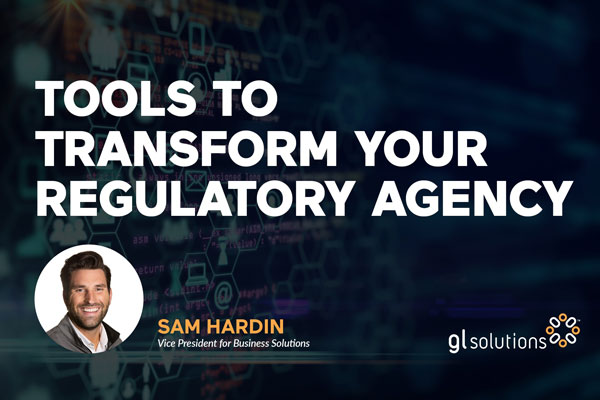Asking a busy licensing official to think about licensing software can be like asking a firefighter to discuss new equipment while battling a blaze. Sure, that new ladder truck might come in handy a few months from now. But … the house is on fire!
Not only are licensing officials in government agencies constantly busy, especially during renewal season, but technology changes continually. It can be hard to keep up with basic licensing-system improvements, to say nothing of deciphering irritating terminology. SQL, SaaS, FedRAMP, GUI, hybrid hosting and so on. It’s no wonder so many agencies stick with Excel spreadsheets, Access databases and paper processes despite their limitations.
At some point, though, the limitations of old technology force agencies to evolve. This can be a frightening experience, in part because licensing officials may not know what to look for in a software solution for government.
We describe the basic components and functionalities of a comprehensive licensing system. We’ve divided them into three categories: automation, efficiency and continuous improvement.
Automation
Why automation? Software automation can help licensing specialists, inspectors and others in the public sector reduce the amount of work they do. It can accomplish this either by doing the work for them or by moving that work elsewhere.
Online Self-Service
Government services websites that allow applicants and licensees to enter information themselves in an online application are the most significant labor-saving improvement your agency can make. They virtually eliminate staff data entry and cut down significantly on the number of calls agencies receive from licensees and the public. They also can allow licensees to update addresses and other information rather than asking your staff to do it.
Self-service websites typically address the following components of the licensing process:
- Renewals: These allow your licensees to log on to an online portal and submit the information your agency requires for license renewal, including continuing professional education hours. They also can allow licensees to make payments online.
- Applications: These sites allow professionals to submit information needed for initial licensure, from test scores and proof of education to professional references. They also can allow online payments. The information provided by applicants flows directly into your agency’s system, eliminating data entry work.
- Complaints: These public portals allow citizens to submit complaints about your licensees. This information also flows directly into the agency’s system and can be routed automatically to the correct staff person for the review process.
- License Verification: These sites allow the public to check on the status and disciplinary history of licensees. Such sites should communicate with your agency’s licensee database, allowing for real-time status review.
Data Interfaces
Data interfaces manage the sharing of information between your licensing software system and other systems. They can be set up to move information into your system and out of your system automatically without any direct staff involvement. This can reduce labor significantly.
Common interfaces include the following:
- Exam imports: These allow testing organizations to send test results to your licensing system, typically on a regular schedule.
- Continuing education imports: These allow approved CE providers to send results directly to your system, helping your staff track compliance with CE requirements. CE tracking tends to be a time-consuming and tedious job without the assistance of interfaces.
- Data exports to other agencies: The statuses of those you license often are relevant to other government agencies. By regularly sharing new and updated licensing information, your system ensures that peer agencies make decisions based on current information.
- Background checks: Such interfaces can share information with third parties such as Fieldprint that conduct background checks. For agencies with the proper permissions, they also can allow system users to search criminal and mental-health databases directly.
- Application imports: Interfaces can allow your government agency to import applications handled by other organizations such as the National Association of State Boards of Accountancy.
- Interface safeguards: Interfaces should feature automatic alerts that provide critical information. They should tell your agency when jobs have completed and whether they’ve succeeded. They also should alert staff when problems occur.
Communication
The licensing software should communicate with staff when action is required. The system also should store communication between the agency and peer agencies.
Commonly managed communication types include:
- New applications: The system should alert staff when applications are ready to review
- Investigation results. The system should tell staff when these are available.
- Information requests: The system should alert staff when public information requests are submitted and require action.
- Automated emails: The system should send email notifications automatically when conditions are met – for instance, when an application is complete.
- Automatic retention: The system should save sent and received emails to the appropriate record automatically, eliminating the need for manual sorting.
- Email management: Meet your document retention requirements by automatically storing inbound and outbound emails within the application; customize the feature to fit your agency’s needs.
Batch processing
Admittedly, this term makes most people’s eyes glaze over. But batch processing can save an enormous amount of time by managing routine activities automatically.
Some common examples of this capability include:
- Renewals: Whatever your agency’s license renewal schedule happens to be, your system should send notifications to your licensees automatically at the appropriate time. Notifications could be emailed or texted automatically. They also could be posted to your agency’s online license renewal website.
- Auditing: Your system should send notifications to licensees and applicants automatically when certain conditions are met. For example, it could send a notification to applicants when they’ve met all the requirements for licensure. It also could send notifications to licenses selected for continuing education auditing. Systems can even choose a percentage of licensees at random for CE auditing, then send them automatic notifications.
- Escalating notifications: The system should send notifications (e.g. first, second and final) and store them on the appropriate record.
- Late fees: The system should calculate and assess late fees, then send notifications automatically.
Efficiency
Almost everything a licensing software system does is designed to increase efficiency, including the functionalities listed above, under automation. For our purposes here, though, automation refers to work that a system can remove from your staff entirely. Efficiency refers to work that a system can help your staff do much more quickly.
Staff Dashboards: Your system should feature dashboards that show staff all required work along with due dates. Supervisor dashboards should provide a view of all staff tasks and allow them to be reassigned as needed. Dashboards help staff prioritize work and get it done on schedule. They also allow supervisors to balance workload and respond to staff absences.
Defined Workflow: While dashboards show staff what to do and when to do it, defined workflow tells them how to do it. The system’s workflow should guide staff through each business process (how to conduct an investigation, for example) as well as from one business process to another (from an investigation to an inspection). With appropriate guidance, staff complete work more quickly and with fewer mistakes.
Batch Data Entry: This capability affects all data entry activities that involve more than one record. Rather than doing the same thing over and over again, a licensing specialist using batch data entry capability can do it just once for many records. Common examples include approving many applications or renewals at one time and applying a single payment to multiple records.
Mobile Enabled: Inspectors and other staff in the field should be able to access the system over mobile devices such as laptops and tablets. This capability allows them to enter data and update records in the system from remote locations, eliminating the need to key in data again upon returning to the office. Mobile functionality also should include geostamping, which discourages fraudulent behavior by establishing that inspectors are where they are supposed to be.
Virtual wallet: Your licensees receive a digital license to conveniently store in their mobile digital wallet.
Website communication: A website communication portal supports two-way communication, enabling a flow of questions and answers between your agency and licensees or providers.
Continuous Improvement
A licensing system will boost the efficiency with which your department processes applications, renewals and inspections; tracks continuing education credits and manages similar work. A well-designed system also will provide feedback that highlights opportunities to increase efficiency further. By continuously improving your agency’s performance, your system can help you provide better customer service while highlighting your success to your board and to legislators.
Key Performance Indicators
Because government software systems track every action taken by users, they can expose inefficient processes as well as those that produce unusually large numbers of mistakes. Armed with such information, licensing officials can review and improve the way their staff work.
Common key performance indicators include:
- Average time from “open” to “complete” for standard processing activities
- Time required for manual data entry
- Inquiry rates for applications, renewals and other standard processes
- Accuracy rates for applications, renewals and other standard processes
- Late response rates
By monitoring key performance indicators, licensing officials also can spot areas in which their software works less efficiently than it should. Your agency’s system and support plan should allow for continuous adjustment following go-live.
Comprehensive Reports
Reports provide snapshots of your government agency at work. Some, like key performance indicators, can measure staff and software efficiency. Others can show work volume and status, helping managers to rebalance and reprioritize to meet agency objectives. Reports, including graphical Business Intelligence reports, are essential tools for communicating your agency’s performance and value to board members and legislators.
Common reports include:
- Applications and renewals by status
- Enforcement cases by status and date
- Open claims by status and date
- Open inspections by inspector and date
- Financial reports, including daily deposits and reconciliation
- Reports required to satisfy internal audit procedures
Run, Grow and Adapt
Subscribe to our newsletter to receive the latest regulatory news delivered to your inbox each week.
GL Solutions helps governments run, grow and adapt. To learn more, explore our website, call us at 800.930.1193 or email us at hello@glsolutions.com.


